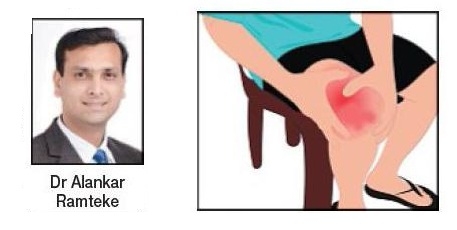Tracing osteoarthtrits in knee easy; city doc’s paper in intl journal
| Date :09-Jul-2020 |

Principal Correspondent :
With the advent of technology, most young doctors depend on more and more investigations instead of going for clinical diagnosis. Sometimes patients and their relatives get fed up of those investigations. There is another angle to this particular aspect. Nowadays, taking patients especially the old age ones to the hospital is a difficult task. Dr Alankar Ramteke, Arthritis specialist, thought can anything be done as far as making proper diagnosis for osteoarthritis in knee and he came with the questionnaire. The paper dedicated to this particular aspect was submitted to international journal and was published. The study will not only help doctors to diagnose patients but also benefit the patients.
Title of the paper is ‘Can We Predict Severity of Osteoarthritis of Knees and Compartmental Involvement Based on a Set of Predefined Clinical Questions in Patients of Knee Pain?’ Dr Ramteke, a well-known Knee and Hip Reconstruction and Replacement Surgeon explained, “Knee has three compartments broadly - 1. Medial Tibio Femoral (MTF) compartment 2. Lateral Tibio Femoral (LTF) compartment 3. Patello femoral (PF) compartment Radiographic Osteoarthritis is graded with help of Kellgren Lawrence Grades (KL Grades) - Grade 1 and 2 are mild to moderate and Grade 3 and 4 are severe. (TF OA is tibiofemoral OA - it can be Medial (Inside of knee) Tibio Femoral (MTF OA) or Lateral (Outside of knee) (LTF OA). Damage behind Knee cap is Patello Femoral (PF) OA).”
“We did not come across any study that investigated the correlation of walking, stair climbing, squatting and sitting cross legged with a particular compartment of the knee such as TFOA or PFOA. One of our aims was to correlate daily activities like walking, stair climbing, squatting and sitting cross legged with OA knees either in TF or PF compartments,” said Dr Ramteke. Explaining further Dr Ramteke said, “Patients with severe isolated Patello Femoral OA do not have pain on walking. But they have pain on stairs and getting up from chairs. If there is pain on climbing stairs, the patient needs support to climb stairs or is unable to climb stairs due to pain, the patient is 4.105 times likely to have advanced PFOA (means damage behind knee cap)." “Similarly, if there is pain on getting up from a chair with support or patient is unable to get up from a low or high chair due to pain there is a likelihood of advanced PFOA,” pointed out Dr Ramteke. If patients have pain on squatting they have high probability of severe knee Medial Compartment. If there is pain on squatting or the patient is unable to squat, there is the likelihood of advanced pain in the middle of knee, added Dr Ramteke.
“If patients have pain on sitting cross legged they have high probability of severe (KL grade 3 or 4) knee Medial Compartment OA (Odds ratio 20). If there is pain on sitting cross legged or the patient is unable to sit cross legged there is 20.09 times likelihood of advanced MTFOA (inside of knee),” said Dr Ramteke. Dr Ramteke cautions obese patients as according to him they are likely to have more pain as compared to Radiographic OA grades. “We would like to emphasise obese patients can experience more knee pain even though advanced radiographic OA (damage behind knee cap) may or may not present,” said Dr Ramteke. “We have not come across any previous study that can predict the likelihood of involvement of a particular compartment relating to physical activities particularly squatting and sitting cross legged. This is the strength of our investigation,” Dr Ramteke made it clear.